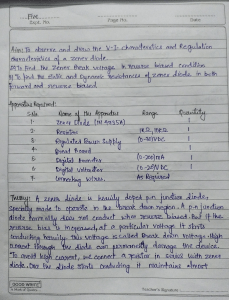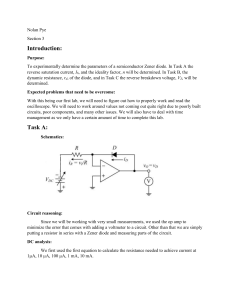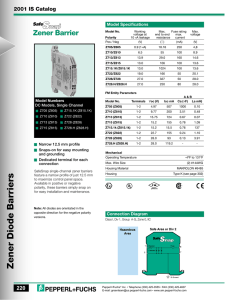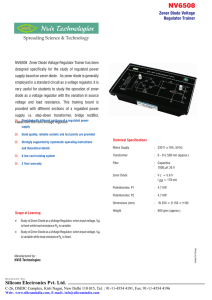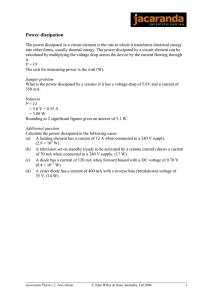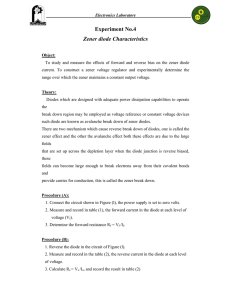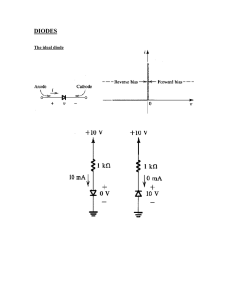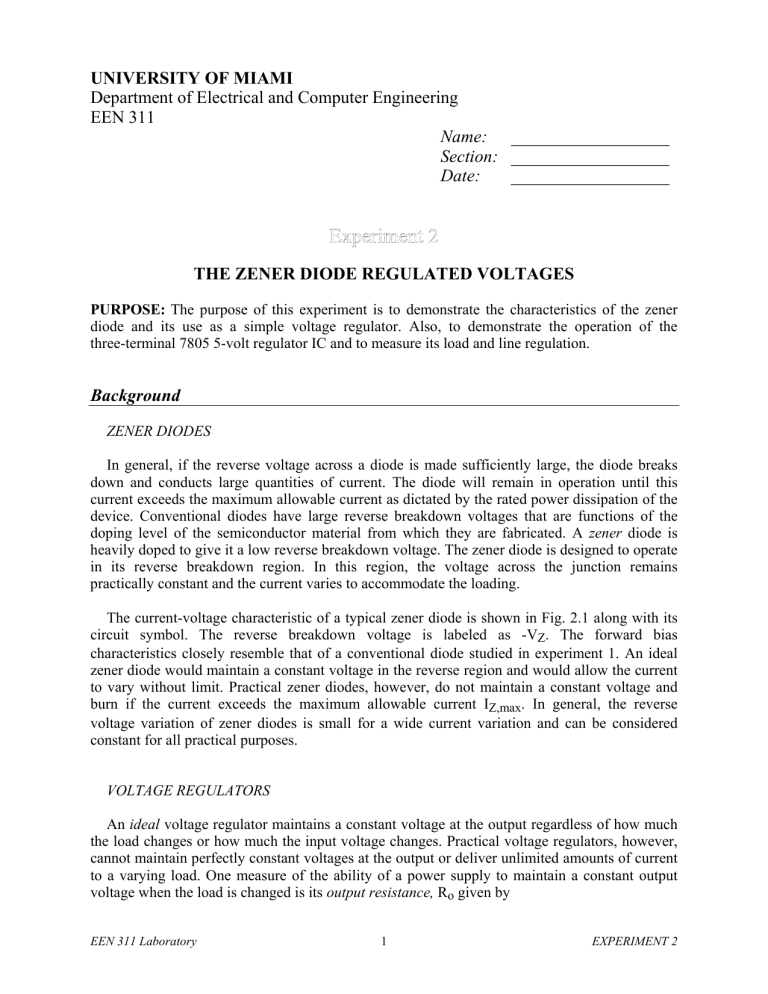
UNIVERSITY OF MIAMI Department of Electrical and Computer Engineering EEN 311 Name: __________________ Section: __________________ __________________ Date: THE ZENER DIODE REGULATED VOLTAGES PURPOSE: The purpose of this experiment is to demonstrate the characteristics of the zener diode and its use as a simple voltage regulator. Also, to demonstrate the operation of the three-terminal 7805 5-volt regulator IC and to measure its load and line regulation. Background ZENER DIODES In general, if the reverse voltage across a diode is made sufficiently large, the diode breaks down and conducts large quantities of current. The diode will remain in operation until this current exceeds the maximum allowable current as dictated by the rated power dissipation of the device. Conventional diodes have large reverse breakdown voltages that are functions of the doping level of the semiconductor material from which they are fabricated. A zener diode is heavily doped to give it a low reverse breakdown voltage. The zener diode is designed to operate in its reverse breakdown region. In this region, the voltage across the junction remains practically constant and the current varies to accommodate the loading. The current-voltage characteristic of a typical zener diode is shown in Fig. 2.1 along with its circuit symbol. The reverse breakdown voltage is labeled as -VZ. The forward bias characteristics closely resemble that of a conventional diode studied in experiment 1. An ideal zener diode would maintain a constant voltage in the reverse region and would allow the current to vary without limit. Practical zener diodes, however, do not maintain a constant voltage and burn if the current exceeds the maximum allowable current IZ,max. In general, the reverse voltage variation of zener diodes is small for a wide current variation and can be considered constant for all practical purposes. VOLTAGE REGULATORS An ideal voltage regulator maintains a constant voltage at the output regardless of how much the load changes or how much the input voltage changes. Practical voltage regulators, however, cannot maintain perfectly constant voltages at the output or deliver unlimited amounts of current to a varying load. One measure of the ability of a power supply to maintain a constant output voltage when the load is changed is its output resistance, Ro given by EEN 311 Laboratory 1 EXPERIMENT 2 Ro = Vo ohms I L Where Vo is the change in output voltage that occurs when the load current changes by IL. Manufacturer’s specifications for load regulation usually give a “typical” and a “maximum” value for Vo corresponding to a specified value of IL. The output resistance of an ideal voltage regulator is zero and that of a practical regulator is in the order of milliohms. The measure of how well a regulator is able to maintain a constant output voltage when the input voltage changes is called its line regulation. Line regulation is often specified as the change in output voltage, Vo, that occurs for a specific change in input voltage, Vin, when the load current is constant. Fig. 2.6 shows the V-I characteristics of practical current-limited voltage regulator. Note the rapid voltage cutoff that occurs when the load tries to draw more than rated current from the regulator. In this experiment we will investigate two simple voltage regulator circuits. The first is a zener diode voltage regulator circuit as shown in Fig. 2.5; the second uses the 7805 series voltage regulator IC as shown in Fig. 2.7. Fig. 2.5 shows a simple voltage regulator circuit that uses a zener diode. The zener diode is operated in its reverse breakdown region so the voltage drop across it will remain practically constant. In order for the circuit to operate properly, the circuit must be designed such that the current across the diode remains above IZ,min (see Fig. 2.1). The designer must always keep in mind the following factors: I. The input voltage VC (remember from experiment 1 that this voltage is unregulated and ripples around a nominal DC voltage) must always remain above a value that will successfully supply current above breakdown to the zener diode and supply load current to RL. II. The load RL must not become too small and keep the zener diode from sinking the necessary current to keep it in the breakdown region (i.e., if RL is shorted, no current will flow across the diode). III. The power dissipation in the zener diode, PZ = VZIZ, must not exceed the maximum rated power dissipation, PZ,max (i.e., if RL is open circuited, all the supply current flows through the zener diode). The first two conditions require that VC and RL be large and the third condition requires that they be small. The series limiting resistance R in Fig. 2.5 must be carefully designed so that all conditions are met. The following inequalities bound the range of permissible values that R can take provided we know the supply and load variations as well as the zener diode specifications. EEN 311 Laboratory R (VC ) min V Z ( I Z ) min V Z /( R L ) min R (VC ) max V Z ( I Z ) max V Z /( R L ) max 2 EXPERIMENT 2 Where (VC)min and (VC)max are the minimum and maximum values of the unregulated input VC, (IZ)min is the minimum reverse current required to keep the diode in breakdown, (IZ)max is the maximum reverse current that can be tolerated without exceeding the rated power dissipation of the diode, (IZ)max PZ,max/VZ, and (RL)min and (RL)max are the minimum and maximum values of the load resistance. Fig. 2.7 shows the 7805 three-terminal integrated circuit voltage regulator. The device has three terminals. One is the unregulated input voltage, the second is the circuit ground, and the third is the regulated output voltage. The 7805 is a 5-V regulator, that is, the output will remain constant at 5 volts provided that the input voltage and the load remain within their permissible limits. EEN 311 Laboratory 3 EXPERIMENT 2 Preliminary Work 1. The voltage-current characteristic of a typical Zener diode is shown in Fig. 2.1. The maximum current, IZ,max, that may flow through a Zener without damaging it is limited by the maximum allowable power dissipation, PZ,max. The minimum Zener current, IZ,min, that is required to keep the diode in its active region is usually given as 0.1IZ,max. If PZ,max = 1W for a given Zener diode with VZ = 8.2V, find IZ,max and IZ,min. + vD iD (mA) - - VZ vD 0.7 iD (Volts) Iz,min Figure 2.1 Voltage-Current Characteristics for a Typical Zener Diode 2. Find Vout in the following circuit if i) VIN < VZ, and ii) VIN > VZ. R + + + VIN VZ - Vout - - Figure 2.2 Simple Zener Diode Rectifying Circuit 3. Show that the maximum allowable load current, IL,max, is bounded as IL,max 0.9IZ,max for the safe and proper operation of the following circuit (i.e., the zener remains in the active region and does not burn for load current values between 0 IL IL,max. IL R + VIN + + I IN VZ - Vout LOAD - IZ - Figure 2.3 Zener Voltage Regulator Circuit with Load. EEN 311 Laboratory 4 EXPERIMENT 2 Experimental Procedure I. Zener Diode Characteristics: Set up the circuit shown in Fig. 2.4. Oscilloscope Channel 2 R = 1 K + 110 Vrms 60 Hz V1 - + IR V2 Oscilloscope Channel 1 ID - VD + Figure 2.4 Simple Zener Diode Circuit Apply a sinusoidal input signal of frequency 60 Hz using a transformer. Engage the "X vs Y" mode in the time scale knob of the oscilloscope. In this mode, channel 1 input signal provides horizontal deflection. Hence, the horizontal axis will represent the diode voltage VD. Channel 2 input signal provides vertical deflection; therefore, the vertical axis will represent the voltage drop across the 1K resistor, which is proportional to the resistor current. VR = R IR VR IR = R VR IR = 1000W = VR milliamps. Consequently, the vertical axis may be assumed to represent the resistor current in milliamps, which is also equal to the negative diode current (since the two currents are in opposite directions). Therefore the resulting pattern on the oscilloscope screen will be the VD vs (-ID) characteristics of the zener diode. To have the proper VD vs ID curve, you can invert the polarity of channel 2 input signal by engaging the "CH 2 INV" function of the oscilloscope. EEN 311 Laboratory 5 EXPERIMENT 2 Sketch the resulting pattern. ID ( ) VD ( ) Zener Diode V-I characteristics Mark the zener voltage on the graph and use this value for the next part. II. Zener Regulated Power Supply: Design the circuit of Fig. 2.5 for a ripple voltage Vr equal to 5% of the peak full-wave bridge rectifier output voltage and for load currents IL between 0 and 1mA. Be careful to design R in accordance to the equations given in the supplemental notes. Recall from experiment 1 that the output voltage of the transformer is around 20 Vpeak and that the voltage drop across the diode bridge is about 2VD 1.4 V. Hence, the peak full-wave rectifier output voltage will be around 18.6 V and the ripple will be 0.93 V. The variation of VC will then be between 17.67 and 18.6 volts. After designing for R, calculate C from the expression VDC - VZ Vr 2f RC . o 1 Where VDC = (VC)max - 2 Vr. Make sure you choose a value of R that will result in a practical and available value of C since resistors are easier to find. IL VC + 110 Vrms V1 60 Hz - + Diode Bridge Rectifier R V2 C RL VZ - C:______ - R:______ + + VL - RL:_________(choose for IL,max) Figure 2.5 Zener Regulated Power Supply. EEN 311 Laboratory 6 EXPERIMENT 2 a) Set the oscilloscope to DC mode and sketch the waveform patterns of VC and VL. Show the ripple voltage Vr present in VC clearly. Use the oscilloscope in DC mode. VC ( VL ( ) t ( ) ) t ( Capacitor Voltage ) Load Voltage b) Slowly vary RL, first by decreasing it to a value of 50 , then increasing it up to (open circuit). Observe the effects carefully; they are to be discussed in the last part (see Discussion of the Results, question 5. c) Remove the transformer, bridge rectifier, and capacitor in Fig. 2.5 and replace them with a DC voltage source so that it looks like the circuit in Fig. 2.3. To determine the line regulation, with RL = 10 k, set VIN to 15 V. Measure the load voltage VL. Repeat this procedure for each value of VIN listed in Table 2.1. V IN (Volts) 15 16 17 18 19 20 V L (Volts) 6.24 6.24 6.25 6.26 6.27 6.27 Table 2.1 Zener Regulator VIN vs VL Data. EEN 311 Laboratory 7 EXPERIMENT 2 d) To determine the output resistance of the regulator, with VIN = 15 V and RL = 20 K, measure the load voltage VL. Repeat this procedure for each value of RL listed in Table 2.2. R L (k) 20 18 16 14 12 10 V L (Volts) IL VL RL I IN V INL V L R I Z I IN I L PZ V L I Z 6.25 6.25 6.25 6.25 6.25 6.25 Table 2.2 Zener Regulator Data for Variable Loading and Constant Input Voltage. EEN 311 Laboratory 8 EXPERIMENT 2 SPICE Set R = 560 in Fig. 2.3. Use the .DC command in SPICE to adjust the line voltage VIN. To model the zener diode, use a diode with a BV (breakdown voltage) equal to the zener voltage. With RL set to 1 k, run SPICE to determine the minimum value of VIN that will keep the zener diode in “regulation”. Discussion of the Results 1. Using the values obtained in Table 2.1, calculate the line regulation, ∆VL/∆VIN, for the zener voltage regulator circuit of Fig. 2.5. 2. Using the values obtained in Table 2.2, calculate the output resistance, ∆VL/∆IL, for the zener voltage regulator circuit of Fig. 2.5. 3. Explain your observations for part II.b. 4. Write a conclusion. EEN 311 Laboratory 9 EXPERIMENT 2


